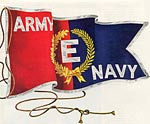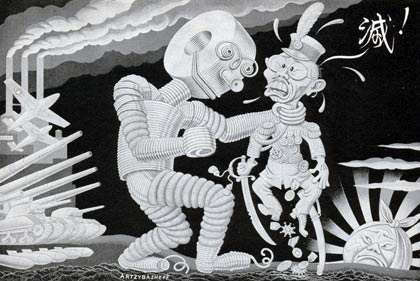1944: Buffao Industry Works for the War
Use the controls to move through the 24 images.
 By 1944, advertising had refined its appeal to Americans to be patriotic by buying products, war bonds, keeping up morale, etc. Although none of the ads above show it, a common theme was 'no matter how much war work we do, it is nothing compared to what they have done.'
By 1944, advertising had refined its appeal to Americans to be patriotic by buying products, war bonds, keeping up morale, etc. Although none of the ads above show it, a common theme was 'no matter how much war work we do, it is nothing compared to what they have done.'
To recongnize war production excellence, i.e. overcoming production obstacles, avoiding work stoppages, maintaining fair labor standards, etc., the federal government adapted a Navy "E" award and renamed it the "Army-Navy E Production Award." By the time the awards were discontinued in December, 1945, 4,283 plants (over half of which employed fewer than 500 employees) had been awarded. This represents 5% of the total number of companies working for the war effort. Companies which received the award were authorized to fly the flag at left at their facilities and to employ the pennant logo in their communications. Of the above selected ads, seven include the award pennant.

Boris Artzybasheff
Boris Artzybasheff (1899-1965) came to America from the Ukraine. He was an illustrator who became well-known for his magazine artwork. He designed 200 Time Magazine covers. In the Buffalo Chamber of Commerce centennial magazine, the above ad is featured; it is titled by the artist, "Steel-Wire Warrior," and his name appears on the image. The artist created 23 advertisements that for Wickwire Spencer duirng the war years and illustrate his ability to transform machine and machine parts into human beings. One of several webs about Artzybasheff is here.
Buffalo was a prime beneficiary of war production work, beginning in 1939. By 1943, Buffalo ranked 9th of 33 industrial areas in the U.S. in total production, ahead of Pittsburgh, Baltimore, St.Louis, et al, having secured $2,100,000,000 in war contracts. Buffalo manufactured almost everything necessary for the war; the 1944 Buffalo Evening News Almanac pages excerpted here show the wide range of manufacturing. (this pdf file is large)
In 1943, out of 458,000 in the work force in Buffalo, over 225,000 were employed in war production. Worker shortages were the rule, and with some difficulty prejudices against African-American workers and women with children were abrogated in order to meet the demand for workers. Despite the local retailers' cheerful note that it was, "Christmas every week in Buffalo" with the prosperity that wartime wages brought, housing shortages were severe as a result of the influx of workers and their families.
An excerpt from and article in the Chamber of Commer Centennial magazine, 1944, entitled, "Buffalo in the Post-War World:"
"Can Buffalo be sure of its share of prosperity if the country as a whole is prosperous after the war?...
"It is up to Buffalo's leaders in every walk of life to recognize the post-war potentialities of the area, to take steps to ensure favorable government policies and to jump in with initiative and courage to provide a high level of employment and business activity in Buffalo.
...Buffalo's post-war business prospects are now being determined for better or for worse. A little foresight, a little thought, a little action, can make the difference between a Buffalo which has its fair share of national prosperity and a Buffalo which is floundering in the midst of a depressed industries and unemployed workers."
Harold M. Somers, Ph.D. economist
